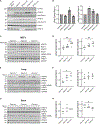PPM1M, an LRRK2-counteracting, phosphoRab12-preferring phosphatase with a potential link to Parkinson's disease
- PMID: 40690364
- PMCID: PMC12462683
- DOI: 10.1016/j.celrep.2025.116031
PPM1M, an LRRK2-counteracting, phosphoRab12-preferring phosphatase with a potential link to Parkinson's disease
Abstract
Leucine-rich repeat kinase 2 (LRRK2) phosphorylates a subset of Rab GTPases that regulate receptor trafficking, and LRRK2-activating mutations are linked to Parkinson's disease. Rab phosphorylation is a transient event that can be reversed by phosphatases, including protein phosphatase, Mg2+/Mn2+ dependent 1H (PPM1H), which acts on phosphorylated Rab 8A (phosphoRab8A) and phosphoRab10. Here, we report a phosphatome-wide small interfering RNA (siRNA) screen that identified PPM1M as a phosphoRab12-preferring phosphatase that also acts on phosphoRab8A and phosphoRab10. Upon knockout from cultured cells or mice, PPM1M displays selectivity for phosphoRab12. As shown previously for mice harboring LRRK2 pathway mutations, knockout of Ppm1m leads to primary cilia loss in striatal cholinergic and parvalbumin interneurons. We also identified a rare PPM1M mutation in patients with Parkinson's disease that is catalytically inactive when tested in vitro and in cells. These findings identify PPM1M as a key player in the LRRK2 signaling pathway and provide a new therapeutic target for the possible benefit of patients with Parkinson's disease.
Keywords: CP: Cell biology; CP: Neuroscience; LRRK2 kinase; Parkinson’s disease; Rab GTPase; phosphatase; primary cilia.
Copyright © 2025 The Author(s). Published by Elsevier Inc. All rights reserved.
Conflict of interest statement
Declaration of interests P.B. and C.B. are employees of CENTOGENE GmbH (Rostock, Germany).
Figures







Update of
-
PPM1M, a LRRK2-counteracting, phosphoRab12-preferring phosphatase with potential link to Parkinson's disease.bioRxiv [Preprint]. 2025 Mar 19:2025.03.19.644182. doi: 10.1101/2025.03.19.644182. bioRxiv. 2025. Update in: Cell Rep. 2025 Aug 26;44(8):116031. doi: 10.1016/j.celrep.2025.116031. PMID: 40166354 Free PMC article. Updated. Preprint.
References
MeSH terms
Substances
Grants and funding
LinkOut - more resources
Full Text Sources
Medical
Molecular Biology Databases
Research Materials
Miscellaneous

